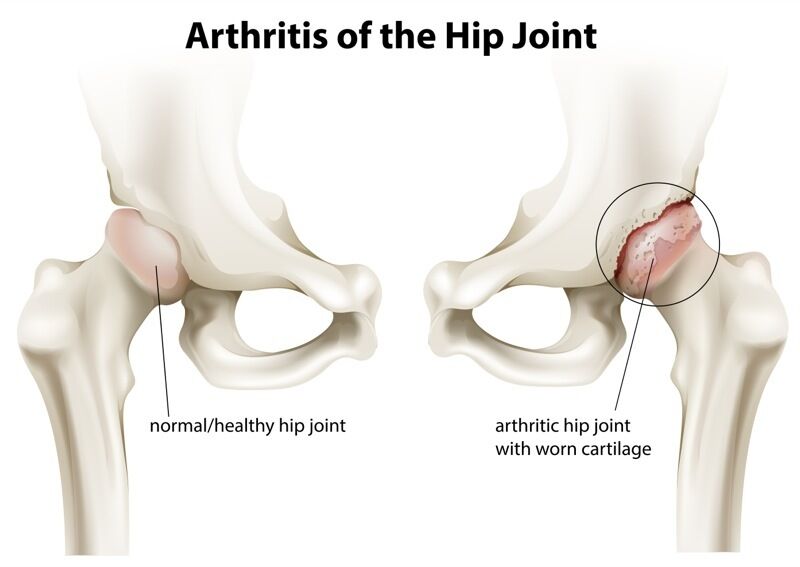What is arthritis of the hip?
Osteoarthritis is a common condition that many people develop during middle age or older. It can occur in any joint in the body, but most often develops in weight-bearing joints, such as the hip. It develops from the chronic wear-and-tear of the cartilage in the hip joint. When the cartilage is worn away, bone-to-bone contact is present, causing severe pain, decreased function and range of motion. As the cartilage wears away, it becomes frayed and rough, and the protective joint space between the bones decreases. This can result in bone rubbing on bone. To make up for the lost cartilage, the damaged bones may start to grow outward and form bone spurs (osteophytes). Hip specialist, Dr. Austin Chen is available to diagnose and treat osteoarthritis of the hip in patients living in greater Boulder, Colorado.

What are the symptoms of arthritis of the hip?
- Osteoarthritis of the hip causes pain and stiffness. It can make it hard to do everyday activities like bending over to tie a shoe, rising from a chair, or taking a short walk.
- Pain in your groin or thigh that radiates to your buttocks or your knee
- Pain that flares up with vigorous activity
- Stiffness in the hip joint that makes it difficult to walk or bend
- “Locking” or “sticking” of the joint, and a grinding noise (crepitus) during movement caused by loose fragments of cartilage and other tissue interfering with the smooth motion of the hip
- Decreased range of motion in the hip that affects the ability to walk and may cause a limp
- Increased joint pain with rainy weather
What are the risk factors for hip arthritis?
Osteoarthritis has no single specific cause, but there are certain factors that may make you more likely to develop the disease, including:
- Increasing age
- Family history of osteoarthritis
- Previous injury to the hip joint
- Obesity
- Improper formation of the hip joint at birth, a condition known as developmental dysplasia of the hip
Even if you do not have any of the risk factors listed above, you can still develop osteoarthritis.
What are the treatment options for arthritis of the hip?
Although there is no cure for osteoarthritis, there are many treatment options to help you manage pain and stay active. Non-surgical options include changing your physical activity routine, using assistive devices, undergoing a personalized nutrition regime and pain management.
Non-surgical options:
Lifestyle Changes: Some changes in your daily life can protect your hip joint and slow the progress of osteoarthritis.
- Minimizing activities that aggravate the condition
- Switching from high-impact activities (like jogging or tennis) to lower impact activities (like cycling or swimming -with the exception of breast stroke) will put less stress on your hip.
- If applicable, weight loss can reduce stress on the hip joint, resulting in less pain and increased function.
Physical therapy. Specific exercises can help increase range of motion and flexibility, as well as strengthen the muscles in your hip and leg. Your doctor or physical therapist can help develop an individualized exercise program that meets your needs and lifestyle.
Nutrition. Along with his wife, a nutritionist, Dr. Chen has created a nutrition and dietary regime to help support osteoarthritis.
Assistive devices. Using walking supports like a cane, crutches, or a walker can improve mobility and independence. Using assistive aids like a long-handled reacher to pick up low-lying things will help you avoid movements that may cause pain.
Medications. If your pain affects your daily routine, or is not relieved by other nonsurgical methods, your doctor may add medication to your treatment plan.
- Acetaminophen is an over-the-counter pain reliever that can be effective in reducing mild arthritis pain. Like all medications, however, over-the-counter pain relievers can cause side effects and interact with other medications you are taking. Be sure to discuss potential side effects with your doctor.
- Nonsteroidal anti-inflammatory drugs (NSAIDs) may relieve pain and reduce inflammation. Over-the-counter NSAIDs include naproxen and ibuprofen. Other NSAIDs are available by prescription.
- Corticosteroids (also known as cortisone) are powerful anti-inflammatory agents that can be taken by mouth or injected into the painful joint.
- Cannabidiol (CBD). CBD is a cannabis compound from the hemp plant that has significant medical benefits, but does not contain THC, the compound that is attributed to the high feeling of marijuana. It is a non-psychoactive compound and has shown to be very effective in offering relief from inflammation and pain.
Surgical options:
Hip Replacement – A total hip replacement involves removing the existing arthritis and placing a metal cup in the socket and a metal stem down the femur. There is a plastic, polyethylene, liner that is placed between the metal ball and socket to provide a non metal-on-metal weight bearing surfaces. After a hip replacement patients are generally allowed to bear weight as tolerated. This procedure can be done through an anterior or posterior approach an as outpatient or single night inpatient stay in the hospital.
Hip Resurfacing– A hip resurfacing is considered a type of total hip replacement. Surgery involves removing the existing arthritis and placing a metal cap over the femoral head and a metal cup in the socket – metal-on-metal bearing surface. This allows for smooth movement of the hip joint. A hip resurfacing has the advantage of preserving more of the patients native bone of the femur. This procedure is performed through a posterior approach. After a hip resurfacing patients are generally allowed to bear weight as tolerated.
